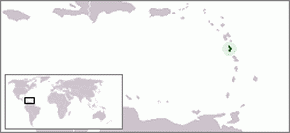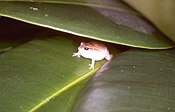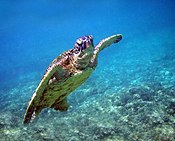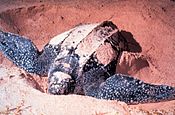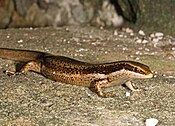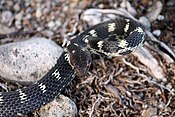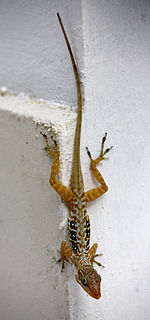
Anolis oculatus, the Dominica anole, Dominican anole, eyed anole or zandoli, is a species of anole lizard. It is endemic to the Caribbean island of Dominica, where it is found in most environments. The species is found in a diverse range of color forms, which one herpetologist once classified as four subspecies, which most other scientists did not recognise because the forms gradually inter-grade with one another. Two later researchers have instead promoted the "ecotypes" concept, hypothesizing the color forms are maintained by the ecological conditions of the surrounding environment, despite being genetically indistinguishable. The morphology of some traits is subject to clinal variation, gradually changing from one side of the island to the other, or from sea level to the hilltops. The ground color ranges from pale tan or yellow to deep green or brown. It also has patterned markings that range from light-colored speckling to complex marbled patterns, and some populations also have large black-ringed "eye" spots on their flanks.

The Dominican ground lizard or Dominican ameiva is a species of lizard. It is endemic to the Caribbean island of Dominica, an island noted for its intact and abundant reptile population, where it is most commonly found in dry coastal woodland.
The Dominican blind snake or Dominican worm snake is a species of blind snake that is endemic to the Caribbean island-nation of Dominica, in the Lesser Antilles.

The fantastic least gecko, or fantastic sphaero is a species of gecko found in the Caribbean, on the islands of Dominica, Montserrat, and the Guadeloupe archipelago.
Vincent's least gecko is a species of lizard in the family Sphaerodactylidae. The species is endemic to the Caribbean.

Gymnophthalmus underwoodi, called commonly Underwood's spectacled tegu, is a species of microteiid lizard, which is found in South America and on certain Caribbean islands.

The little-scaled least gecko is a gecko species mainly found on the Caribbean island of Saint Lucia, where it was once thought to be endemic. It has falsely been recorded on St. Croix, Martinique, Monito Island, the British Virgin Islands, and Costa Rica, but does not exist there.
Sphaerodactylus parvus is a gecko endemic to the Anguilla Bank of islands in the Lesser Antilles, which comprises Anguilla, Saint Martin, and Saint Barthélemy. It was elevated to species level in 2001, formerly described as a subspecies of S. macrolepis.

The island least gecko is a species of gecko endemic to the Lesser Antilles in the Caribbean.

Anolis sabanus, the Saba anole or Saban anole, is a species of anole lizard that is endemic to the island of Saba, a Dutch municipality in the Caribbean Lesser Antilles.
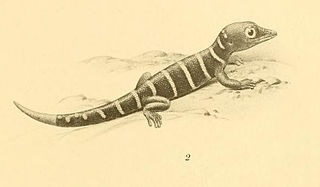
The Antigua least gecko is a gecko endemic to the island nation of Antigua and Barbuda in the Caribbean Lesser Antilles, where it is found on both main islands.
The Guadeloupe blind snake or Guadeloupe worm snake is a species of blind snake that is endemic to Guadeloupe, located in the Caribbean Lesser Antilles. It is fairly widespread on the main islands of Basse-Terre and Grande-Terre, but is not recorded on the other Guadeloupean islands.

The Dominica skink is a species of skink found in Dominica. On Dominica, it can be confused with Gymnophthalmus pleii or juvenile Ameiva fuscata due to their similar appearance.
Note: Species listed above are presumed to be supported by all references unless otherwise cited.
